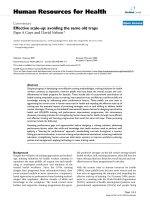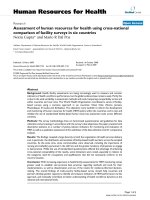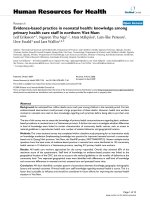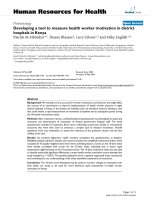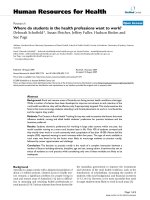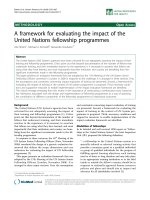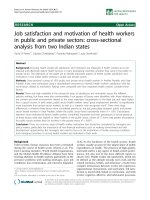báo cáo sinh học:" Initial community perspectives on the Health Service " ppt
Bạn đang xem bản rút gọn của tài liệu. Xem và tải ngay bản đầy đủ của tài liệu tại đây (204.72 KB, 5 trang )
BioMed Central
Page 1 of 5
(page number not for citation purposes)
Human Resources for Health
Open Access
Research
Initial community perspectives on the Health Service Extension
Programme in Welkait, Ethiopia
Haile Negusse
1
, Eilish McAuliffe
1,2
and Malcolm MacLachlan*
1,3
Address:
1
Centre for Global Health, Trinity College Dublin, Dublin 2, Republic of Ireland,
2
School of Medicine, Trinity College Dublin, Dublin 2,
Republic of Ireland and
3
School of Psychology, Trinity College Dublin, Dublin 2, Republic of Ireland
Email: Haile Negusse - ; Eilish McAuliffe - ; Malcolm MacLachlan* -
* Corresponding author
Abstract
Background: The Health Service Extension Programme (HSEP) is an innovative approach to
addressing the shortfall in health human resources in Ethiopia. It has developed a new cadre of
Health Extension Workers (HEWs), who are charged with providing the health and hygiene
promotion and some treatment services, which together constitute the bedrock of Ethiopia's
community health system.
Methods: This study seeks to explore the experience of the HSEP from the perspective of the
community who received the service. A random sample of 60 female heads-of-household in a
remote area of Tigray participated in a structured interview survey.
Results: Although Health Extension Workers (HEWs) had visited them less frequently than
planned, participants generally found the programme to be helpful. Despite this, their basic health
knowledge was still quite poor regarding the major communicable diseases and their vectors.
Participants felt the new HESP represented an improvement on previous health provision. HEWs
were preferred over Traditional Birth Attendants for assistance with labour
Conclusion: While the introduction of HEWs has been a positive experience for women living at
the study site, the frequency of visits, extent of effectively imparted health knowledge and affects
of HEWs on other health providers needs to be further explored.
Background
While low income countries have limited resources for
training healthcare professionals, the migration of those
who are trained to conventional international standards
has made dependence on such cadres increasingly precar-
ious [1]. Low income countries are therefore increasingly
looking to new 'mid-level cadres' (health workers who
work 'above' the level of responsibility usually afforded
health workers with similar training in higher income
countries) to provide healthcare [2]. Research is urgently
needed on the impact of these new categories of staff
upon the provision of better health services in low income
countries [3].
It is widely acknowledged that Ethiopia has an inadequate
health service, with most of the rural, nomadic pastoralist
and fringe areas having little access to it. However, even
those services that do exist are underutilized due to eco-
nomic and social barriers [4]. In response to Ethiopia's
chronic shortfall in conventionally qualified health work-
Published: 24 August 2007
Human Resources for Health 2007, 5:21 doi:10.1186/1478-4491-5-21
Received: 20 March 2007
Accepted: 24 August 2007
This article is available from: />© 2007 Negusse et al; licensee BioMed Central Ltd.
This is an Open Access article distributed under the terms of the Creative Commons Attribution License ( />),
which permits unrestricted use, distribution, and reproduction in any medium, provided the original work is properly cited.
Human Resources for Health 2007, 5:21 />Page 2 of 5
(page number not for citation purposes)
ers, and amidst some of the worst health indicators in
Africa – including the second largest number of HIV pos-
itive people on the continent – the Ethiopian government
introduced the Health Service Extension Programme
(HSEP) in 2003. This innovative programme is the com-
munity-based foundation stone of the government's new
primary healthcare strategy.
By 2005, 2612 HEW's had been deployed in rural villages
across the country, following a one-year post-secondary
school training in essential public health (child care) and
hygiene (for instance, cooking practices and latrine con-
struction), including health promotion (concerning, for
instance, HIV/AIDS, Malaria and tuberculosis) and lim-
ited treatment interventions (the provision of medication
to treat malaria). Although not directly comparable, as it
focused only on lay health workers, a recent Cochrane
review [5] supported their effectiveness in improving
immunization uptake and in reducing child morbidity
and mortality in low and middle-income countries. Lewin
et al.'s review gives support to calls for the development of
health worker cadres that have shorter training, work in
the community and may have more narrowly focused
skills [6-8]. The present paper is a provisional exploration
of a new cadre of health workers in Ethiopia.
By mid 2006, 398 HEWs had been deployed in 33 rural
villages of the Tigray Region, of Ethiopia. This study,
undertaken one year after the initial implementation
period, sought early feedback from the villagers who had
experienced the service, in order to identify areas that
might need further development as the programme
evolves so as to help the programme achieve its ambitions
aims. The research was conducted in six villages in
Welkait, one of the most remote areas in Tigray, northern
Ethiopia, and as such, one of the most challenging areas
in which to improve health services. It was motivated by
the need to increase understanding of human resources
for health in low income countries, and in particular the
impact of a new cadre of health workers. Specifically, we
sought to ascertain the knowledge gained by community
members through the HEW programme; the degree of
community support for the programme and community
perceptions regarding HEWs.
Methods
Context
It is important to understand the extremely challenging
context in which the HEWs reported on here were operat-
ing. Adiremets is the central area of theWelkait woreda (or
administrative district) in which the study was set. It is
700 km from the regional capital, Mekelle, and 1500 km
from the Ethiopian capital, Addis Ababa. Over three quar-
ters of the woreda population live more than 10 km (> 2
hours one way walking time) from any sort of health pro-
vision [9]. Almost all (96%) of the woreda's 121 572
(DHO) people live in a rural area; there are only 112 reg-
istered pit latrines; one motorised and 54 hand pumps;
and 4 protected wells, giving only 18% of the population
access to clean drinking water. There is one central digital
public phone and few community roads (only used dur-
ing the dry season) with no electric supply to the district.
Malaria, intestinal parasites, diarrhoea and tuberculosis
are prevalent, with malaria accounting for approximately
a quarter of the disease-related burden [9].
Sampling and procedure
A cross-sectional community-based interview survey
using quota-based random sampling across 6 villages was
conducted in Welkait. The interview included some open
and some closed questions. It was prepared in English and
translated into Tigrinya, and then back-translated into
English, to ensure consistency. The themes addressed are
reported below.
Six villages in the district which had received the HEW
programme for a period of one year constituted the study
site. All female household heads above 18 years, who
were permanent residents of the study area and had been
visited by HEWs for the last year, comprised the study
population. Ten households from each kushet (village)
were selected by simple random sampling, of every third
household moving in a straight line, until the predeter-
mined number of ten households (that fulfilled our crite-
ria) from each village was met.
The average age of participants was 32.8 (SD = 8.23) years,
93% were illiterate, and 77% had a household income of
less than $150 per year. Forty-nine women were married,
10 divorced, & 1 single. The average walking time to the
nearest health facility was 3.35 hours, each way.
Results
Contact with Health Extension Workers
All participants had received visits from their HEW (recall
this was an inclusion criteria), although only 12% had
seen their HEW at the recommended weekly intervals, and
3% at two-weekly intervals. Some 85% received visits at
only monthly or less frequent intervals. Some 27% did
not know the name of their HEW.
Themes addressed by Health Extension Workers
As part of the HEP, HEWs are supposed to provide educa-
tion to women in households on a number of issues.
Using an open question format, we asked participants
what they had received education on. To summarise this
data we content analysed the responses into themes. In
descending order, the following themes were reported as
being addressed: personal and environmental hygiene
(83%), cooking practices (75%), cleaning and plastering
Human Resources for Health 2007, 5:21 />Page 3 of 5
(page number not for citation purposes)
of house (47%), construction of pit latrine and waste dis-
posal (37%), immunisation of children (23%), separa-
tion of people and animals (22%), and use of
contraception (13%). While it is possible that HEWs
judge that not every household needs education on all of
the issues above (perhaps because they already indicate
awareness of them), it is likely that the coverage of issues
may be less than optimal, as, for instance, pit latrine con-
struction, child immunization and contraceptive use, are
under-practised behaviours according to independent
research (HMIS, 2005).
Health knowledge of respondents
Participants were subsequently asked directly if the HEWs
taught them about disease control and prevention, to
which 80% responded positively. Those participants were
asked to name the three most common communicable
diseases: HIV/AIDS, Malaria and tuberculosis were named
by 53%, 57% and 68% respectively of the 48 respondents;
although only 18% mentioned all three. As regards under-
standing of how these diseases could be communicated,
less than half (43%) knew that unprotected sex was a
mode of transmission for HIV/AIDS, or that malaria was
transmitted by mosquito bites (47%); while just over half
(52%) knew that TB was an airborne disease.
Participants' impressions of Health Extension Workers
Participants were asked to describe their own relationship
with their HEW using a 4-point scale. The responses given
were "very helpful" (58%), "a bit helpful" (30%), "doesn't
make much difference" (3.3%) and "a bit unhelpful"
(8%); Nobody endorsed the "very unhelpful" option. Par-
ticipants also reported on their impression of HEWs'
knowledge, again using a closed response format. They
indicated that the HEWs' knowledge was "very good"
(58%), "medium" (18%), and "poor" (5%), with 18%
indicating that they were not able to evaluate the HEWs'
knowledge.
Sixty percent of the sample indicated that HEWs helped
them with home treatment of common illnesses, and all
but one of these was for febrile illnesses, including
malaria. We also wanted to know what effect the presence
of HEWs might have on services provided by other cadres
of health workers, and in particular, Traditional Birth
Attendants, in this region. This was felt to be a useful point
of comparison as TBAs are one of the few groups of co-
existing health service providers in the region. Ninety-
three per cent of participants indicated that they would
prefer HEWs to assist them during labour, rather than Tra-
ditional Birth Attendants. The reasons given in discussion
of this response were that the HEWs seemed more knowl-
edgeable, but also that they were closer to hand, and/or
that there were no TBAs in their village. Finally, 57% of all
respondents reported that the Health Services Extension
Programme offered by the HEWs represented an improve-
ment over previous health provision.
Discussion
The results reported here represent a preliminary review of
the impact of a specific group of HEWs, working in per-
haps some of the most challenging conditions to be found
in Ethiopia. Yet it is in just such remote and poorly sup-
ported environments that the benefits of the HSEP may be
most valuable. Following the one-year training pro-
gramme, which is targeted at (only) female school leavers,
the HEWs are assigned to the villages with which they are
to work. Although the HEWs were supposed to visit
households weekly, this had not happened. The reasons
for this clearly need to be ascertained, but anecdotal
accounts suggested a lack of administrative support and
monitoring may be partly responsible. Indeed, it has been
suggested that particularly for lower-level cadres, the pro-
vision of appropriate supervision to encourage an ethic of
professionalism, is likely to be very important [3]. The
strengthening of support systems for HEWs may therefore
be a fruitful avenue for further investigation.
The low levels of knowledge reported by participants
regarding the major communicable diseases is very worry-
ing. Imparting health-promoting information in a non-
standard environment, when mothers may have other
demands being placed upon them, is without doubt a
challenging task. However, the 'bringing into the home
environment' of the information and the HEW is a crucial
element of the HSEP, both symbolically and practically.
Given the well established difficulties of communicating
health information to poorly educated people [10], it may
be that more attention should be paid during training to
the process of imparting information and to villagers' pre-
paredness to assimilate such information.
While personal circumstances no doubt influence the top-
ics HEWs discuss with women, some topics – e.g. contra-
ception & immunization – clearly need wider discussion.
We would recommend the use of focus group discussions
with HEWs to explore the reasons why some topics are
covered in some households, but not in others; and per-
haps to identify ways of enabling HEWs to more effec-
tively advise on areas that they feel less comfortable
discussing with householders.
The fact that an overwhelming majority of participants
expressed a preference to be attended by a HEW rather
than a Traditional Birth Attendant during labour is an
interesting and rather surprising finding. Provision of a
health worker with midwifery skills at every birth, coupled
with access to emergency hospital obstetric care are the
most crucial interventions for safe motherhood. Over the
past 15 years many TBAs have been given midwifery train-
Human Resources for Health 2007, 5:21 />Page 4 of 5
(page number not for citation purposes)
ing as part of the Safe Motherhood Strategy. The HEWs in
Ethiopia do not receive training in midwifery skills, yet
this research suggests that they may be called upon to
attend births in the community. There has been much
debate about the effectiveness of TBAs, with some claim-
ing that they have had little impact on maternal mortality
[11]. However, other studies have shown clear commu-
nity preferences for TBA's health care particularly amongst
rural dwellers [12]. This perception is thought to be par-
tially influenced by the fact that community members see
TBAs as members of their extended families who can
understand and communicate in the local language with
an understanding of the local culture. It may be that this
same perception applies to the HEWs. Whilst acknowledg-
ing that there is wide variability across developing coun-
tries in the level of knowledge, skills and experience of
TBAs, the unintentional undermining of their role by
other cadres of health workers is a real danger. As Wal-
raven & Weeks point out "we are in danger of wiping out
the useful work along with the weaknesses, rather than
building on strengths and correcting shortcomings" [11].
What is needed therefore is not another cadre of health
workers (HEWs) replacing or 'competing with' TBAs, but
a cadre that can complement the work of TBAs to ensure a
more comprehensive coverage in terms of maternal health
services. Finally, we wish to stress the importance of not
drawing substantive conclusions from the small sample
that participated in this research, and the corresponding
small number of TBA's about whom opinions were
sought. We further acknowledge that the training of TBA's
can vary considerably and that in comparing HEWs with
TBAs were are not comparing like with like, in terms of
level of education, length of training, remuneration, etc.
These issues make all the more critical the thinking
through of optimal skill mix across different health pro-
viders.
HEWs do provide treatment, but only of febrile diseases
(mostly malaria). The treatment of intestinal parasites and
diarrhoeal diseases (as the other most prevalent diseases
in Ethiopia) should be encouraged in the training of
HEWs, particularly as these rural communities live such
distances from the nearest health facility. Another role the
HEWs could play is in TB treatment. They could address
this also if they had been trained in direct observation
treatment (DOTS), a treatment regime which is also being
considered for anti-retroviral administration.
Despite the challenges noted above, the HEWs were
broadly seen as helpful, and as improving general health
service provision. It is important that the gaps in their
knowledge and in particular their abilities to impart infor-
mation are addressed in the training and support of
HEWs. This study points to the need for locally appropri-
ate comprehensive healthcare plans, linking and maxi-
mizing the skills of the HEWs with those of other health
workers, and of providing HEWs with appropriate levels
of support and supervision, perhaps especially in the early
stages of their deployment.
Conclusion
This research is limited by the fact that we cannot with cer-
tainty ascribe any changes to HEWs' inputs, because the
design is neither comparative nor longitudinal. However,
within these limitations, this research indicates notewor-
thy patterns of behaviour that may usefully be fed back
into service development. Although HEWs visited village
households less often than is recommended in the HSEP,
most respondents had positive feeling about the service
offered and felt it to be an improvement compared to
before the HSEP was implemented. Despite this, respond-
ents had worryingly poor knowledge about major com-
municable diseases. They also felt that HEWs were
preferable to Traditional Birth Attendants for assistance
with maternal care. The supervision and support of HEWs
should be reviewed along with the methods used to trans-
fer knowledge and possibly the scope of their therapeutic
interventions. This preliminary investigation is of a mod-
est scale and was set in a particularly challenging geo-
graphical area for health service provision. Nonetheless, it
is hoped these results can contribute to further strengthen-
ing this innovative and much needed health provision
programme.
Competing interests
The author(s) declare that they have no competing inter-
ests.
Authors' contributions
HN contributed to the design, data collection and analy-
sis. EM and MM contributed to the design, analysis, and
write up. All authors read and approved the final manu-
script.
Acknowledgements
We are very grateful to Tigray Health Bureau, Welkait Woreda Health
Office and Welkait Woreda Administration Office for facilitating this study;
to the villagers who kindly participated and to ICOS/Irish Aid for supporting
the research.
References
1. Mc Auilffe E, MacLachlan M: Turning the Ebbing Tide: Knowl-
edge Flows and Health in Low-income Countries. Higher Edu-
cation Policy 2005, 18:231-242.
2. Buchan JMD, Dal Poz MR: Role Definition, Skill Mix, Multi-Skill-
ing, and 'New Workers. In Towards a Global Workforce Strategy:
Studies in Health Services Organisation and Policy Edited by: Ferriho P,
Dal Poz M. Antwerp, ITG Press; 2003:275-300.
3. Hoingoro C, Normand C: Health Workers: Building and Moti-
vating the Workforce. In Disease Control Priorities in Developing
Countries Second edition. New York, World Bank/Oxford University
Press; 2006:1309-1322.
4. CNHDE (Centre for National Health Development in Ethiopia):
Training of Health Extension Workers: First Intake Assessment Addis
Ababa, CNHDE; 2005.
Publish with Bio Med Central and every
scientist can read your work free of charge
"BioMed Central will be the most significant development for
disseminating the results of biomedical research in our lifetime."
Sir Paul Nurse, Cancer Research UK
Your research papers will be:
available free of charge to the entire biomedical community
peer reviewed and published immediately upon acceptance
cited in PubMed and archived on PubMed Central
yours — you keep the copyright
Submit your manuscript here:
/>BioMedcentral
Human Resources for Health 2007, 5:21 />Page 5 of 5
(page number not for citation purposes)
5. Lewin SA, Babigumira SM, Bosch-Capblanch X, Aja G, van Wyk B,
Glenton C, Scheel I, Zwarenstein M, Daniels K: Lay health workers
in primary and community health care: A systematic review.
2006 [ />].
6. Chen L, Evans T, Anand S, Boufford JI, Brown H, Chowdhurry M:
Human Resources for Health: Overcoming the crisis. Lancet
2004, 364:1984-90.
7. Filippi V, Ronsmans C, Campbell OM, Graham WJ, Mills A, Borghi J,
Koblinsky M, Osrin D: Maternal health in poor countries: the
broader context and a call for action. Lance 2006, 368:1535-41.
8. HMIS (Health Management and Information System): Tigray Health
Bureau 1997 EFY profile Mekelle: Tigray Health Bureau; 2005.
9. MacLachlan M: Culture & Health: A Critical Perspective towards Global
Health 2nd edition. Chichester, Wiley; 2006.
10. Walraven G, Weeks A: The role of (traditional) birth attend-
ants with midwifery skills in the reduction of maternal mor-
tality. Tropical Medicine and International Health 1999, 4:527-529.
11. Imogie AO, Agwubike EO, Aluko K: Assessing the Role of Tradi-
tional Birth Attendants (TBAs) in Health Care Delivery in
Edo State, Nigeria. African Journal of Reproductive Health 2002,
6:94-100.



